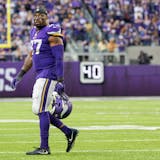Just think, five weeks from today we'll all have the Vikings' final answer. Is general manager Rick Spielman really considering passing on Southern Cal left tackle Matt Kalil with the No. 3 pick in this year's draft?
He couldn't be, could he?
After all, listen to the draft experts and it's very clear Kalil is as close to a can't-miss tackle as you'll ever find in the draft. He's big. He's explosive. He has quick feet and uses his hands well.
On top of that, the Vikings have asserted that they would like to reinforce their offensive line to protect developing young quarterback Christian Ponder. And what could be better than securing a smart, athletic, strong beast up front to ink into the starting lineup for, oh, the next 10-12 years?
Yep, on the surface it sure seems like A+B=You're-out-of-your-darn-mind-if-you-pass-on-Kalil.
Yet Spielman insists he will seriously look at the other side of this coin as well. At the combine last month, he wondered aloud whether championship teams truly require a star left tackle to excel or whether they can still succeed with a functional player there if the offense has real difference makers at the skills positions.
It's a fair question to consider. And after Spielman began that debate, we looked into it a little deeper by analyzing the starting left tackles for the 12 playoff teams in 2011, uncovering evidence that it's by no means necessary to spend a high draft pick on the position in order to win.
Now, as stories continue to surface that Spielman and the Vikings could opt to use that No. 3 pick to address a different position -- LSU cornerback Morris Claiborne is in the conversation and Oklahoma State receiver Justin Blackmon should be too – we're providing another set of data that's worth considering. For those teams who do use top 10 picks on offensive linemen, what kinds of dividends to they usually see? Here's a quick look at the 23 offensive tackles taken in the top 10 over the past 20 drafts.



